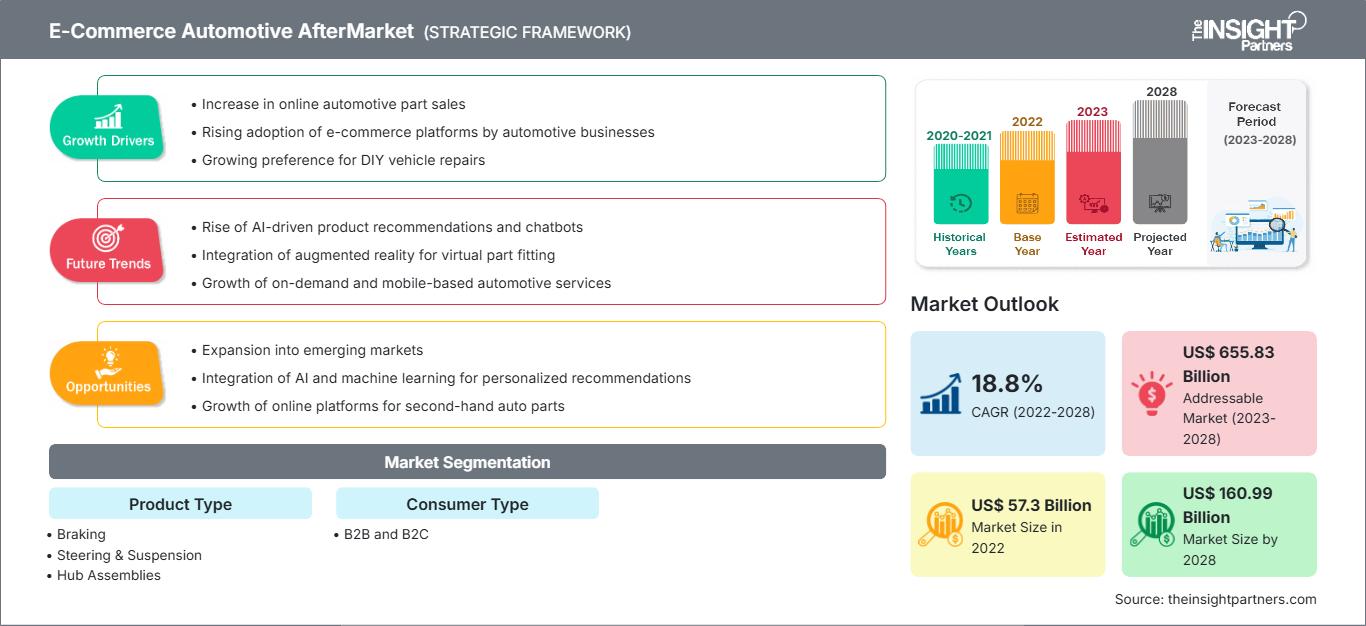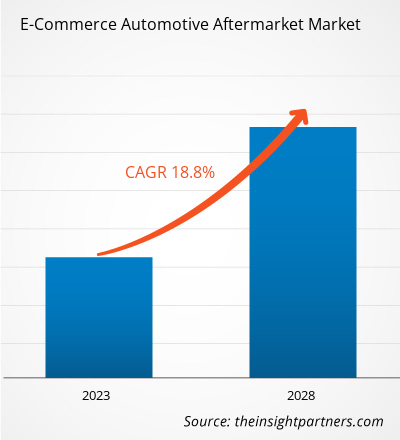Si prevede che il mercato dell'aftermarket automobilistico tramite e-commerce crescerà da 57.301,1 milioni di dollari nel 2022 a 1.60.985,4 milioni di dollari entro il 2028. Si stima una crescita a un CAGR del 18,8% dal 2022 al 2028.
Il Nord America ha un'industria automobilistica sviluppata grazie alla continua produzione di veicoli commerciali. Secondo il rapporto 2021 dell'Organisation Internationale des Constructeurs d'Automobiles (OICA), gli Stati Uniti hanno prodotto 7.604.154 veicoli commerciali nel 2021, 6.895.604 nel 2020 e 8.367.239 nel 2019. Analogamente, il Canada ha prodotto 826.767 veicoli commerciali nel 2021, 1.048.942 nel 2020 e 1.455.215 nel 2019, secondo il rapporto OICA 2021. Il Messico ha prodotto un totale di 2.437.411 veicoli commerciali nel 2021, 2.209.121 nel 2020 e 2.604.080 nel 2019, secondo lo stesso rapporto. Stati Uniti, Canada e Messico sono leader nel segmento della produzione di veicoli commerciali a livello mondiale, secondo le statistiche OICA. Pertanto, la produzione continua di veicoli commerciali in tutta la regione sostiene la crescita del mercato dell'e-commerce aftermarket automobilistico in Nord America.
Impatto della pandemia di COVID-19 sul mercato dell'e-commerce aftermarket automobilistico
In Nord America, Stati Uniti, Canada e Messico hanno registrato un aumento significativo del numero di casi di COVID-19. Molti impianti di produzione sono stati chiusi, le amministrazioni comunali hanno funzionato a un ritmo decelerato e le attività dei settori automobilistico e dei semiconduttori sono state interrotte nel 2020, dopo l'inizio della pandemia di COVID-19. Nella regione, l'interruzione della catena del valore causata dalla chiusura di vari impianti di produzione e magazzini negli Stati Uniti e in Canada a causa della pandemia di COVID-19 ha avuto un impatto immediato sulla domanda a breve termine, sulle infrastrutture logistiche e sulle scorte di prodotti. Tuttavia, l'industria automobilistica ha continuato a crescere grazie ai servizi unici offerti dai canali online in termini di assistenza, riparazione e sostituzione. Prima dell'inizio della pandemia di COVID-19, l'e-commerce era in rapida espansione. Tuttavia, la pandemia ha aumentato il numero di consumatori statunitensi che utilizzano piattaforme online, incoraggiandoli a spendere di più. Queste attività hanno generato un'ampia quota di fatturato grazie alla penetrazione di un ecosistema di e-commerce ben organizzato che consente ai produttori di attrezzature per l'automotive di impegnarsi in vendite aftermarket specifiche per l'e-commerce. Ad aprile 2021, le vendite di componenti, ricambi e accessori per auto nel mercato aftermarket automobilistico e-commerce negli Stati Uniti e in Canada sono aumentate di oltre il 60% rispetto al 2020.
Personalizza questo rapporto in base alle tue esigenze
Potrai personalizzare gratuitamente qualsiasi rapporto, comprese parti di questo rapporto, o analisi a livello di paese, pacchetto dati Excel, oltre a usufruire di grandi offerte e sconti per start-up e università
Mercato dell'e-commerce dei ricambi per autoveicoli: Approfondimenti strategici

- Ottieni le principali tendenze chiave del mercato di questo rapporto.Questo campione GRATUITO includerà l'analisi dei dati, che vanno dalle tendenze di mercato alle stime e alle previsioni.
Potrai personalizzare gratuitamente qualsiasi rapporto, comprese parti di questo rapporto, o analisi a livello di paese, pacchetto dati Excel, oltre a usufruire di grandi offerte e sconti per start-up e università
Mercato dell'e-commerce dei ricambi per autoveicoli: Approfondimenti strategici

- Ottieni le principali tendenze chiave del mercato di questo rapporto.Questo campione GRATUITO includerà l'analisi dei dati, che vanno dalle tendenze di mercato alle stime e alle previsioni.
Approfondimenti sul mercato dell'e-commerce per l'aftermarket automobilistico
Aumento dei consumatori fai da te e DIFM
Amazon ed eBay offrono spedizioni in giornata di aftermarket automobilistico in molte località. Hanno rapporti commerciali con alcuni importanti produttori di ricambi, come Robert Bosch GmbH, Denso Corp., Magna International Inc., Continental AG e ZF Friedrichshafen AG, che offrono servizi di installazione. I fornitori tradizionali di ricambi auto sanno che i clienti che acquistano componenti aftermarket per il fai da te sarebbero il primo segmento a passare ai siti di e-commerce digitale anziché ai fornitori tradizionali di ricambi auto. Pertanto, mantenere un rapporto commerciale costante con commercianti e tecnici è una strategia unica per rimanere competitivi. Le caratteristiche standard delle auto più recenti includono sensori per rilevare i cambi di corsia, telecamere a 360° e tecnologie che richiedono l'assistenza di esperti.
Nella tendenza "fai da te" (DIFM), ci si aspetta che i consumatori che possiedono auto avanzate facciano affidamento su officine di riparazione auto e meccanici. Ad esempio, Advance Auto Parts utilizza l'e-commerce per rivolgersi in modo esclusivo a questi gruppi di mercato, offrendo loro funzionalità di tecnologia di assistenza alla guida. Il mercato dell'aftermarket automobilistico tramite e-commerce deve continuare a sfruttare i mercati digitali B2C (business-to-consumer) e B2B (business-to-business) e le crescenti catene di fornitura che supportano questi mercati, mentre i concorrenti continuano a perseguire questo redditizio mercato dell'aftermarket automobilistico tramite e-commerce. Di conseguenza, si prevede che il crescente numero di clienti che adottano l'acquisto online di componenti per autoveicoli nel settore automobilistico tramite e-commerce creerà nuove opportunità nel mercato dell'aftermarket automobilistico tramite e-commerce.
Approfondimenti di mercato basati sulla tipologia di prodotto
In base alla tipologia di prodotto, il mercato dell'aftermarket automobilistico tramite e-commerce è segmentato in sistemi frenanti (pastiglie freno, componenti idraulici e hardware, rotori e tamburi), sterzo e sospensioni (giunti sferici, tiranti, tiranti della barra stabilizzatrice, cuscinetti/guarnizioni e altri) e gruppi mozzo, giunti cardanici, guarnizioni, filtri, candele e altri. Nel 2021, il segmento "Altri" ha guidato il mercato dell'e-commerce dei ricambi per autoveicoli, rappresentando la quota maggiore del mercato.
Approfondimenti di mercato basati sulla tipologia di consumatore
In base alla tipologia di consumatore, il mercato dell'e-commerce dei ricambi per autoveicoli è segmentato in B2B e B2C. Nel 2021, il segmento B2C ha guidato il mercato dell'e-commerce dei ricambi per autoveicoli, rappresentando una quota di mercato maggiore.
Gli operatori del mercato adottano strategie, come fusioni, acquisizioni e iniziative di mercato, per mantenere le proprie posizioni nel mercato dell'e-commerce dei ricambi per autoveicoli. Di seguito sono elencati alcuni sviluppi dei principali attori:
- A marzo 2022, DENSO Aftermarket, la filiale aftermarket di DENSO, importante produttore di componenti di primo equipaggiamento (OE), ha vinto l'ambito premio Fornitore dell'Anno 2021, assegnato da GroupAuto International, un'organizzazione leader a livello mondiale per gli acquisti.
- A settembre 2020, LKQ Corporation ha completato l'accordo precedentemente annunciato per la vendita delle sue partecipazioni in due grossisti cechi di ricambi per auto a Swiss Automotive Group AG. I termini della transazione non sono stati divulgati.
E-Commerce Automotive AfterMarketMercato dell'e-commerce nel settore dei ricambi per autoveicoli
Le tendenze e i fattori regionali che hanno influenzato il mercato dell'e-commerce dei ricambi per autoveicoli durante il periodo di previsione sono stati ampiamente spiegati dagli analisti di The Insight Partners. Questa sezione analizza anche i segmenti e la geografia del mercato dell'e-commerce dei ricambi per autoveicoli in Nord America, Europa, Asia-Pacifico, Medio Oriente e Africa, America Meridionale e Centrale.
Ambito del rapporto sul mercato dei ricambi per auto e-commerce
| Attributo del rapporto | Dettagli |
|---|---|
| Dimensioni del mercato in 2022 | US$ 57.3 Billion |
| Dimensioni del mercato per 2028 | US$ 160.99 Billion |
| CAGR globale (2022 - 2028) | 18.8% |
| Dati storici | 2020-2021 |
| Periodo di previsione | 2023-2028 |
| Segmenti coperti |
By Tipo di prodotto
|
| Regioni e paesi coperti | Nord America
|
| Leader di mercato e profili aziendali chiave |
|
Densità degli operatori del mercato dell'e-commerce nel settore dei ricambi per autoveicoli: comprendere il suo impatto sulle dinamiche aziendali
Il mercato dell'aftermarket automobilistico tramite e-commerce è in rapida crescita, trainato dalla crescente domanda degli utenti finali dovuta a fattori quali l'evoluzione delle preferenze dei consumatori, i progressi tecnologici e una maggiore consapevolezza dei vantaggi del prodotto. Con l'aumento della domanda, le aziende stanno ampliando la propria offerta, innovando per soddisfare le esigenze dei consumatori e sfruttando le tendenze emergenti, alimentando ulteriormente la crescita del mercato.

- Ottieni il Mercato dell'e-commerce dei ricambi per autoveicoli Panoramica dei principali attori chiave
Alibaba Group Holding Limited; Amazon.com, Inc.; AutoZone, Inc.; Shopee365; CATI SpA; eBay Inc.; LKQ Corporation; The Pep Boys; CarParts.com, Inc; e Denso Corporation sono i principali attori leader del mercato.
- Analisi storica (2 anni), anno base, previsione (7 anni) con CAGR
- Analisi PEST e SWOT
- Valore/volume delle dimensioni del mercato - Globale, Regionale, Nazionale
- Industria e panorama competitivo
- Set di dati Excel
Report recenti
Testimonianze
Motivo dell'acquisto
- Processo decisionale informato
- Comprensione delle dinamiche di mercato
- Analisi competitiva
- Analisi dei clienti
- Previsioni di mercato
- Mitigazione del rischio
- Pianificazione strategica
- Giustificazione degli investimenti
- Identificazione dei mercati emergenti
- Miglioramento delle strategie di marketing
- Aumento dell'efficienza operativa
- Allineamento alle tendenze normative






















 Ottieni un campione gratuito per - Mercato dell'e-commerce dei ricambi per autoveicoli
Ottieni un campione gratuito per - Mercato dell'e-commerce dei ricambi per autoveicoli